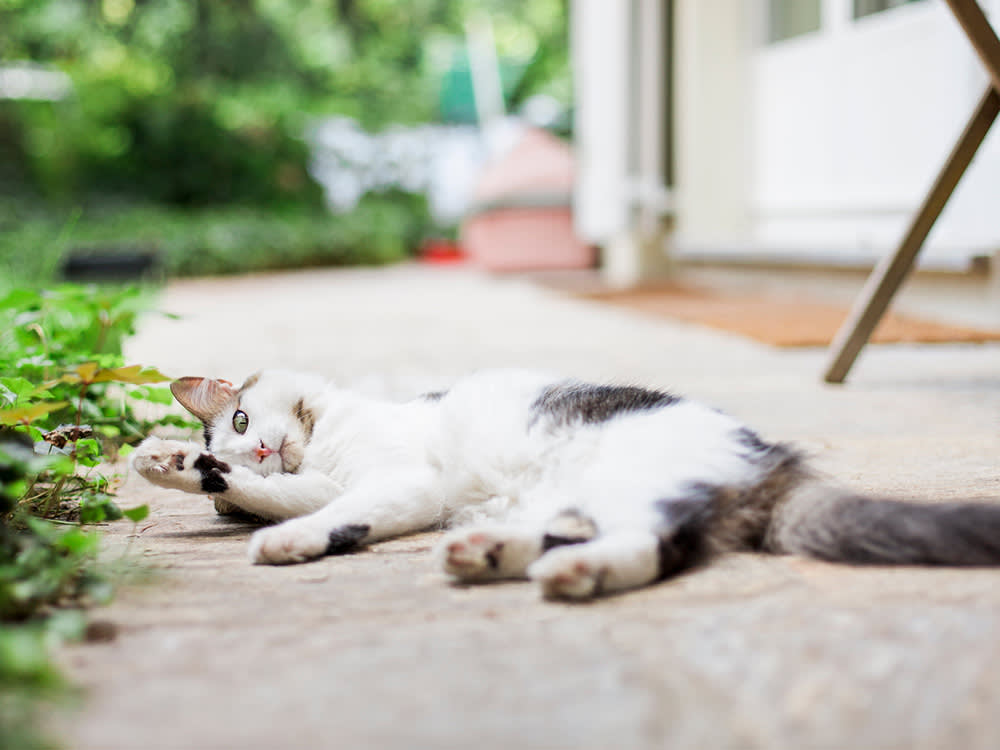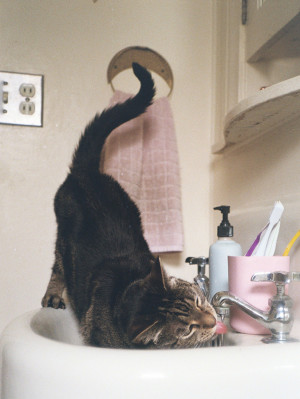What to Know About Tapeworms in Cats
What to look for and how to treat this (and be able to eat rice again).

share article
“Are they short like rice or long like spaghetti?”
This is a common question that veterinary staff members will ask pet parents who call in a panic about worms coming out of their cat’s butt. The appearance of the worms helps to figure out the likely culprit. Roundworms and hookworms kind of resemble spaghetti noodles while tapeworms look like little pieces of rice, if rice could move itself around. Now that you’re sufficiently grossed out, let’s talk about the ones that are short like rice.
What Tapeworms Are
Tapeworms are flat, segmented parasites that commonly infect dogs and cats. Dipylidium caninum — the fancy scientific name for the most common tapeworms in cats — set up shop in a cat’s small intestine. They hook on to the intestinal wall and suck nutrients from the cat.
While the bits of tapeworm visible externally are pretty small, the actual worm inside of a cat can grow to a whopping six to 30 inches. As tapeworms grow, they develop segments called proglottids. These egg-bearing proglottids are released from the tail end of the tapeworm and passed in the cat’s feces. These are the little things that look like grains of rice in an infected cat’s poop.
How Cats Get Tapeworms
Dipylidium tapeworms infect cats through fleas. Animals infected with tapeworms will pass tapeworm eggs (in proglottids) in their feces. Flea larvae eat these eggs, and the eggs remain inside the flea as the flea matures. Once the flea matures, it jumps onto the cat to feed on the cat’s blood. As a cat grooms, the cat will ingest the fleas and the tapeworm eggs inside them.
When the flea is digested, the tapeworm eggs are freed so they can spawn and hook on to the wall of the cat’s small intestine, starting the cycle over again. An important thing to note is that fleas are a necessary part of the process. A cat won’t get tapeworms by eating tapeworm eggs directly.
Symptoms of Tapeworms in Cats
Cats with tapeworms may lick and groom their hind ends excessively. That area likely needs a little extra attention; there are worms crawling out of their butts after all. Some cats may scoot their butts on the ground. The main clue that a cat has tapeworms is seeing the proglottids directly. The tiny, rice-like segments can be found near the cat’s anus or on the cat’s feces. Despite the disturbing visuals, cats with tapeworms typically feel fine and will have normal energy and appetite levels.
Diagnosing Tapeworms in Cats
The most common (and most reliable) way to diagnose tapeworms in cats is by directly watching the little buggers crawl around a cat’s butt or poop. A fecal exam is less reliable than direct observation, but it may be recommended to rule out other intestinal parasites.
Treating Tapeworms in Cats
Treating tapeworms in a cat requires deworming with specific products that are effective against tapeworms, which means a trip to a veterinarian. Not all dewormers will do the job. Deworming is essential to kill the tapeworms, but it’s not the only step. Deworming must be combined with flea control to be effective long-term.
Unfortunately, getting rid of fleas is a multi-step process. The cat and all other furry pets in the house must be given effective flea treatment, and the environment should be cleaned thoroughly by washing bedding and vacuuming regularly. All steps should be performed at the same time and repeated regularly to catch all life stages of the fleas. Otherwise, the stragglers have a chance to thrive and reinfect the cat.
Risks of Tapeworms to People and Pets in Households
A cat with tapeworms cannot directly transmit tapeworms to other people or pets, but, it’s possible for both people and pets to be infected if they ingest an infected flea. This is more commonly reported in children.
Tapeworms are considered common, mild, and easily treated, but they’re often a sign of an underlying flea infestation and are not something anyone wants to deal with in their home. Preventing tapeworms involves putting cats on safe, effective flea prevention, even if they live indoors.
Additional Risks For Cats Who Hunt
Cats can also get a different species of tapeworm called Taenia. Taenia species are transmitted by eating infected rodents. The life cycle for this tapeworm is a little different. Instead of a flea eating tapeworm-infected feces, a rodent ingests them. The eggs develop into larvae and travel to the rodent’s liver, where they develop in cysts. After a cat catches the infected rodent and has a nice meal, the tapeworm larvae mature into adult tapeworms in the cat’s intestines.
Symptoms and treatments for Taenia tapeworms are basically the same as Dipylidium tapeworms, so there’s no need to try to differentiate between the two. Taking measures to prevent a cat from hunting, like keeping them indoors, is the best prevention for Taenia tapeworms.

Dr. Alycia Washington, DVM, MS
Alycia Washington, DVM, is a small animal emergency veterinarian based in North Carolina. She works as a relief veterinarianopens in a new tab and provides services to numerous emergency and specialty hospitals. Dr. Washington is also a children’s book author and freelance writer with a focus on veterinary medicine. She has a special fondness for turtles, honey bees, and penguins — none of which she treats. In her free time, Dr. Washington enjoys travel, good food, and good enough coffee.
Related articles
![Unrecognizable woman petting an ill cat]() opens in a new tab
opens in a new tabNow, Something No One Wants to Talk About: Cat Cancer
Veterinarian Dr. Alycia Washington breaks down the four most common types of cancer in cats, from how to spot the early signs to how to treat them.
![White Persian cat on a blue background]() opens in a new tab
opens in a new tabUTIs Suck for Your Cat, Too
Here’s how to help them get relief.
![Owner pets senior ginger cat.]() opens in a new tab
opens in a new tab6 Common Health Concerns in Senior Cats
How to spot and how to treat them.
![cat sitting in a litter box]() opens in a new tab
opens in a new tabHow to Deal with Cat Diarrhea
Dr. Audrey K. Cook’s tips to getting to the bottom of a sh*tty situation.
![Tabby cat leaning into a porcelain sink, tail curled in the air, as it sticks its tongue out to drink water from the faucet.]() opens in a new tab
opens in a new tabWhy Is My Cat So Damn Thirsty?
No, not like that. They’re literally drinking a lot of water. Here’s when you should be worried.
![Red cat with squinted eyes laying in a basket closeup]() opens in a new tab
opens in a new tab6 Ways Your Cat Could Tell You They Are in Pain
Here are all the way your kitty is trying to tell you they’re hurting.









